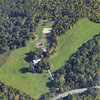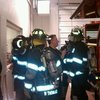2008 in review New Scotland
Citizens rally to fight mall plan, chaos ensues
NEW SCOTLAND 2008 was a year of change and conflict in this formerly quiet town. A new supervisor faced unprecedented development proposals, which were, in turn, met with record opposition by hundreds of residents.
Committee and board members faced charges of conflicts of interest that town officials tried to mediate, only to later refer the charges to county officials or to drop them altogether.
Businesses in town also changed hands, opened, expanded, and closed, while local organizations tried to meet the needs of the town’s aging residents.
The town board lost a full-time assessor, agreed to find a part-time assessor, and approved a $5.6 million budget with a 2-percent increase in the general fund. The board also sought, and received, state funds to build a $450,000 road to close a dangerous railroad crossing that was the site of a double-train and car crash.
Melons, caps, and CZAC
In February, two-year-old Sphere Development, of Cazenovia (Madison Co.), proposed a large-scale retail center at the site of the former Bender melon farm, a 179-acre parcel in one of the few commercial zones in town, at the corner of routes 85 and 85A.
More than 800 residents came out in May to support a moratorium on commercial development over 30,000 square feet, after learning of Sphere’s proposal for the 750,000-square-foot retail center. Later, Sphere said it needed a 137,000-square-foot Target anchor store, but could cut the size of the retail center by half.
The town first passed a six-month moratorium, then extended it three more months to end in March 2009, and is currently considering extending it an additional six months. The board wanted to use the time to align its current zoning, which allows for unlimited retail development in the commercial zone, with its 1994 comprehensive land use plan.
Members of the grassroots organization New Scotlanders 4 Sound Economic Development created size-cap signs that covered the landscape for seven months. The signs called for a size cap of 50,000 square feet for stores.
In September, village officials told residents of Voorheesville that the signs were not allowed, but, within days, the signs were found to be lawful.
“Our zoning law doesn’t list those as an approved sign,” said village Building Inspector Gerald Gordinier. Gordinier said that he contacted an attorney with the New York Conference of Mayors and found that the signs were allowed under the First Amendment.
The size cap of 50,000 square feet matched the cap recommended by Elizabeth Kormos, a member of NS4SED, and a commercial real estate broker, who was one of five members appointed by the town board to the Commercial Zoning Advisory Committee, which was to recommend zoning for the commercial zone.
Kormos was accused of having a conflict of interest after CZAC Chairwoman Roselyn Robinson found that Kormos had represented a smaller-scale development to the owners of the Bender farm almost two years ago.
Months of town board discussions attended by standing-room-only crowds supporting Kormos and the 50,000-square-foot size cap followed the charge, and the town found that it has no system in place to handle a conflict-of-interest hearing. Board members weighed in with their opinions of Kormos’s level of conflict, and passed any responsibility for hearing more on the alleged conflict to Albany County, but only if an interested party asked the county for an opinion. To date, no one has.
In November, immediately following the board’s announcement that it could not hear a conflict charge, three of the five members of CZAC resigned. Robinson, Cynthia Elliott, a planning board member also accused of a conflict because of her work on CZAC, and John Biscone resigned, leaving Kormos and Michael Naughton. Robinson and Elliott presented individual suggestions to the town board favoring no cap at all, with a minimum cap of 125,000 square feet, if needed. Kormos and Naughton gave the board a report favoring a 50,000-square-foot cap.
Amid the year-long chaos, the town board split along party lines, with three Democrats Margaret Neri, Deborah Baron, and Richard Reilly often voting against the lone Republican, Douglas LaGrange. Democratic town Supervisor Thomas Dolin, who took office in January, often voted with LaGrange, while Dolin’s party-mates voted against him.
The Republican Party this fall chose Joseph DeFronzo as its party chairman for a two-year term.
Two town board members and the supervisor are up for re-election next year; 2008 was an off-year for town elections.
“The Republicans wanted to tone it down the development. We do not want a box in that development,” DeFronzo said in the fall. “The time will come next year when there are some bad feelings between the public and the way certain board members voted,” DeFronzo said.
Seniors
Developer Charles Carrow proposed a senior-housing development at the edge of the commercial zone on Route 85 behind a medical building he owns. The town planning and zoning boards reviewed Carrows’s plans for months.
In March, the town board approved a floating senior overlay zone that allows for senior housing to be built on any parcel, regardless of its current zoning designation, providing that it gets approval. The floating zone was an effort to streamline the process for developers, to encourage the growth of senior housing in the town, said Councilman Richard Reilly at the time. Reilly was largely responsible for drafting the bill. It also allowed Carrow to build residences in a commercial zone with municipal water.
The zoning restricts residents to ages 55 and over and allows for a greater density of residents than the zoning calls for. Carrow’s development would be the first senior housing in the town, but it would not be income-dependent; the homes are expected to be moderately priced.
Dolin expressed concern in February over a lack of incentives for low-income senior housing.
“It’s kind of embarrassing, we’re the only one around here that doesn’t allow senior housing. It’s overdue,” Dolin said.
Local organizations responded to residents’ needs for support as Alzheimer’s patients and their caregivers voiced concerns this fall. The town-sponsored senior outreach services bought a small bus from Bethlehem’s senior services and a vehicle that seats four to transport seniors to events and medical offices. Previously, seniors had to climb up steep school bus steps and squeeze into seats designed for children to attend events. They also had to rely on volunteers and their cars to drive them to doctors.
Business as usual
With possible development at the heart of the commercial district looming, business owners banded together this year to form the New Scotland Business Builders, similar to a chamber of commerce.
Some businesses came in to town successfully, like Sabre Technical Services in the old Saab dealership on Route 85. Others folded, like Buona Sera and J.J. Maddens, a restaurant and bar just up the road on Route 85.
Other long-term businesses faced changes in operations. Indian Ladder Farms changed its management style when the owner’s daughter, Laurie Ten Eyck, left. She is now working with the American Farmland Trust. Peter Ten Eyck, the owner, continued to cultivate new customers and new methods as he embraced tunnel farming to expand his growing season.
James Olsen, owner of Olsen’s garden center, proposed plans this fall to erect another building behind the center on route 85 and to create an eatery at the front.


